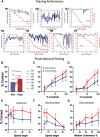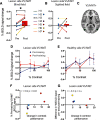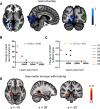Increased Visual Sensitivity and Occipital Activity in Patients With Hemianopia Following Vision Rehabilitation
- PMID: 34035137
- PMCID: PMC8276743
- DOI: 10.1523/JNEUROSCI.2790-20.2021
Increased Visual Sensitivity and Occipital Activity in Patients With Hemianopia Following Vision Rehabilitation
Abstract
Hemianopia, loss of vision in half of the visual field, results from damage to the visual pathway posterior to the optic chiasm. Despite negative effects on quality of life, few rehabilitation options are currently available. Recently, several long-term training programs have been developed that show visual improvement within the blind field, although little is known of the underlying neural changes. Here, we have investigated functional and structural changes in the brain associated with visual rehabilitation. Seven human participants with occipital lobe damage enrolled in a visual training program to distinguish which of two intervals contained a drifting Gabor patch presented within the blind field. Participants performed ∼25 min of training each day for 3-6 months and undertook psychophysical tests and a magnetic resonance imaging scan before and after training. A control group undertook psychophysical tests before and after an equivalent period without training. Participants who were not at ceiling on baseline tests showed on average 9.6% improvement in Gabor detection, 8.3% in detection of moving dots, and 9.9% improvement in direction discrimination after training. Importantly, psychophysical improvement only correlated with improvement in Humphrey perimetry in the trained region of the visual field. Whole-brain analysis showed an increased neural response to moving stimuli in the blind visual field in motion area V5/hMT. Using a region-of-interest approach, training had a significant effect on the blood oxygenation level-dependent signal compared with baseline. Moreover, baseline V5/hMT activity was correlated to the amount of improvement in visual sensitivity using psychophysical and perimetry tests. This study, identifying a critical role for V5/hMT in boosting visual function, may allow us to determine which patients may benefit most from training and design adjunct interventions to increase training effects.SIGNIFICANCE STATEMENT Homonymous visual field loss is a common consequence of brain injury and is estimated to affect more than 230,000 people in the United Kingdom. Despite its high prevalence and well-described impact on quality of life, treatments to improve visual sensitivity remain experimental, and deficits are considered permanent after 6 months. Our study shows that behavioral changes following vision rehabilitation are associated with enhanced visually-evoked occipital activity to stimuli in the blind visual field. Unlike previous behavioral studies, we observe clinical changes that are specific to the trained region of vision. This lends significant weight to such training paradigms and offers a mechanism by which visual function can be improved despite damage to the primary visual pathway.
Keywords: V5/hMT; cortical blindness; functional MRI; hemianopia; perimetry; rehabilitation.
Copyright © 2021 Ajina et al.
Figures







Comment in
-
Neural Mechanisms of Visual Field Recovery after Perceptual Training in Cortical Blindness.J Neurosci. 2022 Mar 9;42(10):1886-1887. doi: 10.1523/JNEUROSCI.1953-21.2022. J Neurosci. 2022. PMID: 35264430 Free PMC article. No abstract available.
References
-
- Andersson JL, Jenkinson M, Smith S (2007) Non-linear optimisation: FMRIB technical report. Oxford, United Kingdom: FMRIB TR07JA1.
Grants and funding
LinkOut - more resources
Full Text Sources
Other Literature Sources
